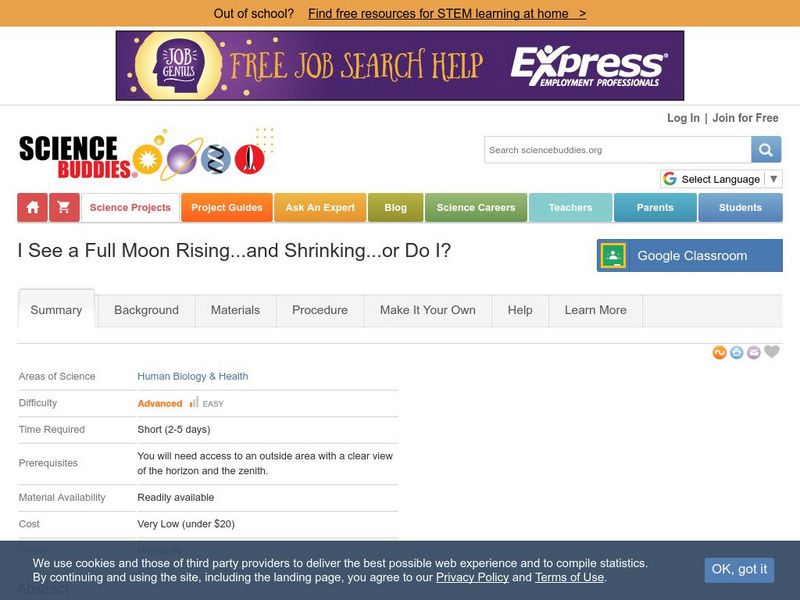Curated OER
Charting the Moon
Sixth graders observe changes in the moon's appearance over a month and keep records of their observations. They write a plan for recording what they see, and a paragraph reflecting on what they have learned over the course of the month.
Curated OER
Phases of the Moon
Sixth graders observe the changes in the moon's appearance over a two week period of time from their homes. They record and illustrate their observations and also complete daytime moon viewings as a class.
Curated OER
Moon Watch
Third graders read books about the moon and discuss its perceived changes as it moves across the sky. They observe the moon over the course of a month and chart their observations. They discuss their observations and conduct further...
Curated OER
Lunar Cycles
Eighth graders conduct internet research on a specific website to collect information about Lunar Cycles.
Curated OER
Day and Night
Learners discuss why day and night occur after visualizing a teacher-led demonstration.
Curated OER
The Differences Between the Earth and the Moon
Fifth graders identify the physical characteristics of the Earth and compare them to the physical characteristics of the moon. They produce a chart with Microsoft Excel to record the physical characteristics of both the Earth and the moon.
Curated OER
How Distant Is The Moon?
Students discover how Aristarchus, a Greek astronomer around 230 BC, used a simple observation of the eclipse of the Moon, plus clever reasoning, to deduce the distance of the Moon. They practice the same calculation technique.
Curated OER
Take a Spin Through the Solar System
Second graders participate in a variety of activities to explore the Solar System in this unit.
Curated OER
Lunar Life Support
Students design and build models of nine life support systems which are crucial to our successful settlement of the Moon. Each team must define the requirements of their system, exploring how these requirements are currently being met on...
Curated OER
Bouncing Sunlight
Third graders use flashlights and balls to demonstrate how the light bounces off of the sun and reflects onto the moon. They record their observations in a journal.
California Institute of Technology
Cool Cosmos: Ask an Astronomer for Kids
Cool Cosmos, a NASA-affiliated site, has compiled a list of frequently asked questions about the moon and linked them to answers provided by actual astronomers! Click back to the Cool Cosmos home to access the Spanish-language version.
Fourmilab Switzerland
John Walker: Named Lunar Formations
This atlas of the Lunar surface features lists all named features. Click on a name and see an image of that item, or at least an image of the Moon centered on that item.
NASA
Nasa: Astronaut Biography: Alan Shepard
Biographical information with personal data, education, organizations, special honors, aviation experience, and NASA experience.
BBC
Bbc Science and Nature: The Moon
The BBC brings together a lot of useful information about the moon and related topics, such as the lunar landings, and publishes it in the form of a traveler's guide.
PBS
Pbs Kids: Design Squad Challenge: Launch It (Pdf) [Pdf]
Hands-on challenge to design an air-powered rocket to take you to the moon that can hit a distant target. Provides full list of materials with ideas on how to design, build, test, evaluate, and redesign it if necessary. Activity focuses...
PBS
Pbs Kids: Design Squad Challenge: Roving on the Moon (Pdf) [Pdf]
Hands-on challenge to build a rubber band-powered cardboard car (rover) that can scramble across the room. Provides full list of materials with ideas on how to build, test, evaluate, and redesign the car if necessary. Activity focuses on...
PBS
Pbs Kids: Design Squad Challenge: On Target (Pdf) [Pdf]
Hands-on challenge to modify a paper cup so it can zip down a line and launch a marble on a target. Provides full list of materials with ideas on how to design, build, test, evaluate, and redesign it if necessary. Activity focuses on the...
PBS
Pbs Kids: Design Squad Challenge: Feel the Heat (Pdf) [Pdf]
Hands-on challenge to heat things up by building a solar hot water heater. Provides full list of materials with ideas on how to design, build, test, and redesign it if necessary. Activity focuses on the engineering design process and the...
Science Buddies
Science Buddies: I See a Full Moon Rising, and Shrinking, or Do I?
The moon appears bigger at the horizon just as it is rising over the treetops, than it does later in the evening when it is overhead. This is because our perception of its size changes based on where it is in the sky. In this human...
Seeker
Seeker: Week of 8 11 14: The Supermoon as Seen Around the World
View images of the recent supermoon phenonemon.
Science Education Resource Center at Carleton College
Serc: Know Your Neighbors: Researching the Planets
Students will study planets and moons in our solar system by working online and other resources. This lesson has students working together to generate a spreadsheet of data found. Students will use this information to describe why Earth...
Chase Young, PhD
Dr. Chase Young, Ph D: Reader's Theater Script: Goodnight Moon [Pdf]
A reader's theater script for Margaret Wise Brown's early childhood book, Goodnight Moon, is provided on these pages. Four character roles are needed in this activity.
Chase Young, PhD
Dr. Chase Young, Ph D: Reader's Theater Script: "How 400,000 People Landed Apollo 11" [Pdf]
A reader's theater script for Dixie Allen's nonfiction book, Team Moon: How 400,000 People Landed Apollo 11 on the Moon, is provided on these pages. Ten character roles are needed in this activity.
Google
Google: Moon
An exciting new way to explore the Apollo moon missions, visit the moon on this interactive map and take a tour of each Apollo landing.






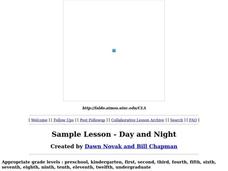


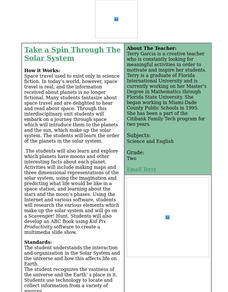



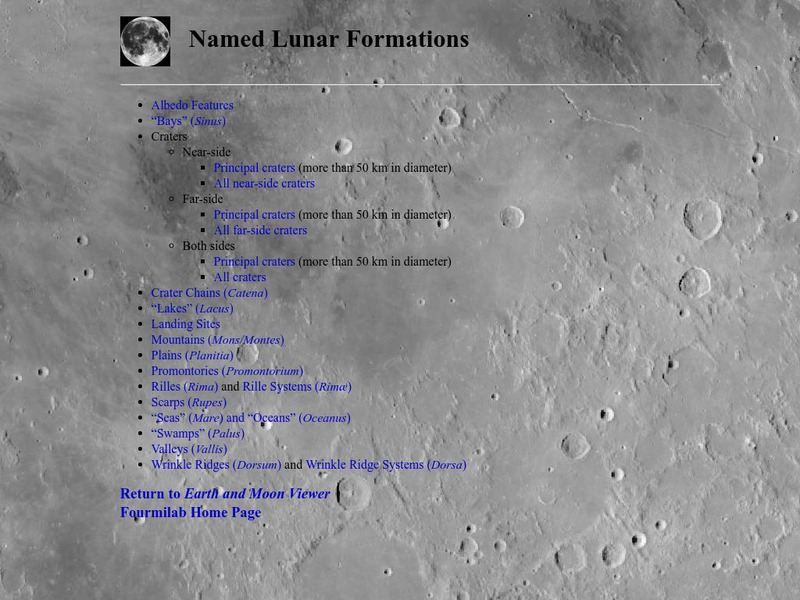

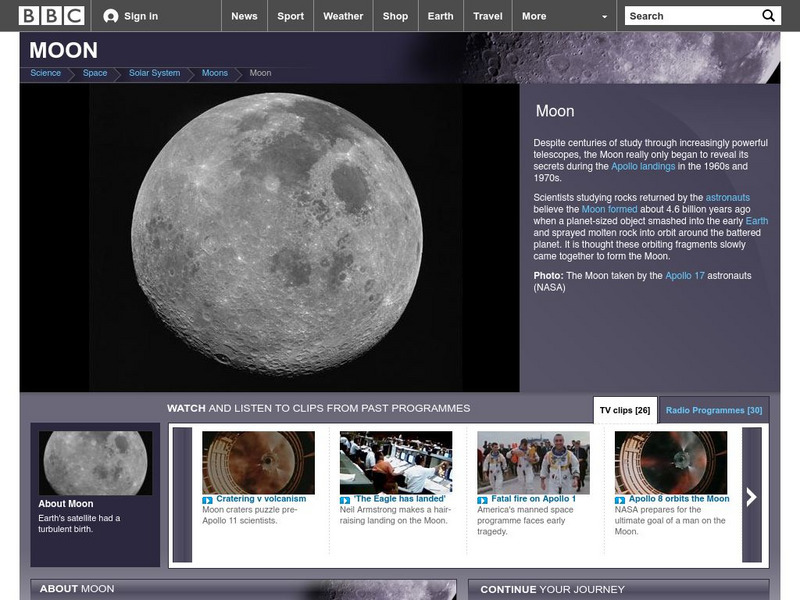
![Pbs Kids: Design Squad Challenge: Launch It (Pdf) [Pdf] Handout Pbs Kids: Design Squad Challenge: Launch It (Pdf) [Pdf] Handout](https://content.lessonplanet.com/knovation/original/36107-c0d2df3d606700761ca15213bf4cfa5c.jpg?1661243842)
![Pbs Kids: Design Squad Challenge: Roving on the Moon (Pdf) [Pdf] Handout Pbs Kids: Design Squad Challenge: Roving on the Moon (Pdf) [Pdf] Handout](https://content.lessonplanet.com/knovation/original/39870-7d15b39a7cd630b206093ca5e091b6de.jpg?1661243845)
![Pbs Kids: Design Squad Challenge: On Target (Pdf) [Pdf] Handout Pbs Kids: Design Squad Challenge: On Target (Pdf) [Pdf] Handout](https://content.lessonplanet.com/knovation/original/39872-01bc33f557ff0ac556d8372138231b49.jpg?1661243848)
![Pbs Kids: Design Squad Challenge: Feel the Heat (Pdf) [Pdf] Handout Pbs Kids: Design Squad Challenge: Feel the Heat (Pdf) [Pdf] Handout](https://content.lessonplanet.com/knovation/original/39873-ae8d75ec09f51ea05c443973c536d5aa.jpg?1661243849)
